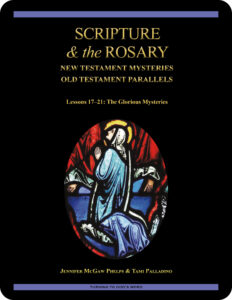 Scripture & the Rosary:
Scripture & the Rosary:
New Testament Mysteries,
Old Testament Parallels
The First Glorious Mystery
Lesson 17 They Went to the Tomb When the Sun Had Risen
the Gospel According to Mark 16:1–11
the Book of Daniel 3:16–20
the Book of Daniel 3:24–25
Revised Standard Version Catholic Edition (RSVCE)*
New American Bible Revised Edition (NABRE)*
Catechism of the Catholic Church
Rosarium Virginis Mariae (Rosary of the Virgin Mary)
ex libris (in our library)
cross references for Scripture & the Rosary
Tami Palladino’s visual-meditation journal
next lesson: Why Do You Stand Looking into Heaven?
This material coordinates with Lesson17 on pages 64–67 in Scripture & the Rosary: New Testament Mysteries, Old Testament Parallels.
And Mary said, “My soul magnifies the Lord, and my spirit rejoices in God my Savior,
for he has regarded the low estate of his handmaiden.
For behold, henceforth all generations will call me blessed;
for he who is mighty has done great things for me, and holy is his name.”
—the Gospel According to Luke 1:46–49
welcome to our in-depth study of Scripture & the Rosary
We invite groups and individuals to become acquainted with Turning to God’s Word Catholic Bible  studies through
studies through  Scripture & the Rosary: New Testament Mysteries, Old Testament Parallels, which has been granted an imprimatur. Although no longer available in print, the first six lessons can be downloaded from our website. The remaining 20 lessons are posted throughout the liturgical year along with their related online study pages. Click here to access Lesson 17 through Lesson 21. If you have a Bible-study question or comment, you can contact our authors any time by using one of the “ask us your question” or “what do you think” buttons on any online study page.
Scripture & the Rosary: New Testament Mysteries, Old Testament Parallels, which has been granted an imprimatur. Although no longer available in print, the first six lessons can be downloaded from our website. The remaining 20 lessons are posted throughout the liturgical year along with their related online study pages. Click here to access Lesson 17 through Lesson 21. If you have a Bible-study question or comment, you can contact our authors any time by using one of the “ask us your question” or “what do you think” buttons on any online study page.
open with prayer
It’s always wise to begin any Bible study with prayer, whether reading the Scriptures alone or meeting with others in a discussion group. You can pray using your own words or use one of the opening prayers on our website. We especially like the following:
Lord Jesus, you promised to send your Holy Spirit to teach us all things.
As we read and study your word today,
allow it to touch our hearts and change our lives. Amen.
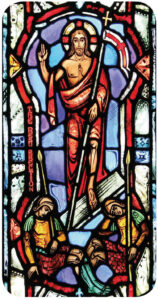 making connections—two views of indestructible life
making connections—two views of indestructible life
Lesson 17 of Scripture & the Rosary: New Testament Mysteries, Old Testament Parallels looks at the First Glorious Mystery, Jesus’ Resurrection. The New Testament text is the Gospel According to Mark 16:1–11, with the Old Testament parallel from the Book of Daniel 3:16–20 and 3:24–25 in the RSVCE translation used in Turning to God’s Word Bible studies. (Numbering of some Bible verses varies in different translations, so if you’re following  along with a NABRE, the Book of Daniel 3:16–20 will be correct, but verses 3:24–25 in the RSVCE will be 3:91–92 in the NABRE.) The Old Testament parallels to the Glorious Mysteries are taken from events in the lives of the Old Testament prophets
along with a NABRE, the Book of Daniel 3:16–20 will be correct, but verses 3:24–25 in the RSVCE will be 3:91–92 in the NABRE.) The Old Testament parallels to the Glorious Mysteries are taken from events in the lives of the Old Testament prophets  Daniel, Elijah, and Isaiah, and from the lives of two significant female figures in the Old Testament, Judith and Esther. Our two-part study Thus Says the LORD: God Speaks Through His Servants the Prophets—Volume I: A Kingdom Divided and Volume II: Restoration & Redemption provides extensive information about all of the biblical prophets.
Daniel, Elijah, and Isaiah, and from the lives of two significant female figures in the Old Testament, Judith and Esther. Our two-part study Thus Says the LORD: God Speaks Through His Servants the Prophets—Volume I: A Kingdom Divided and Volume II: Restoration & Redemption provides extensive information about all of the biblical prophets.
let’s look at the new in the light of the old
As you read through this lesson’s selected passages from the New and Old Testaments, ask yourself what these two biblical accounts have in common. Additional in-depth questions can be found on pages 64–67 in Scripture & the Rosary: New Testament Mysteries, Old Testament Parallels. Clicking on the New and Old Testament stained glass windows will enlarge the art. The same art also illustrates Lesson 17 in Scripture & the Rosary: New Testament Mysteries, Old Testament Parallels.
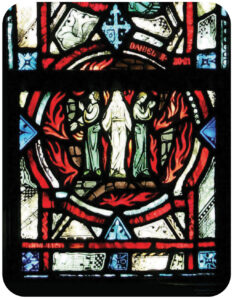 ? Consider which of the key theological virtues (faith, hope, or love) you think is demonstrated most strongly in the account of Jesus’ Resurrection taken from the Gospel According to Mark 16:1–11.
? Consider which of the key theological virtues (faith, hope, or love) you think is demonstrated most strongly in the account of Jesus’ Resurrection taken from the Gospel According to Mark 16:1–11.
? What about in the Old Testament description of Shadrach, Meshach, and Abednego in the fiery furnace?
? Consider whether you can think of any event in the Scriptures that is more glorious than Jesus’ Resurrection.
? What about the Old Testament account of the fiery furnace is particularly glorious, and why do you think that it was chosen as a parallel to Jesus’ Resurrection?
? Think about some other instances in the Scriptures in which fire plays a prominent role.  Does fire have a positive or a negative impact in those situations?
Does fire have a positive or a negative impact in those situations?
? Does fire have a positive or a negative impact in the Old Testament account of Shadrach, Meshach, and Abednego?
? In the account of Jesus’ Resurrection found in the Gospel According to Mark 16:1–11, why do you think it is that the disciples refuse to believe that Jesus is alive?
? What do you think is the purpose of Jesus’ Resurrection?
? What ramifications does Jesus’ Resurrection have for Christians?
? Look at the pictures of the stained glass window panels on pages 64 and 66 in Scripture & the Rosary: New Testament Mysteries, Old Testament Parallels. What similarities do you see between the depictions of these New and Old Testament scenes?
supplemental Scripture
The account of the Resurrection chosen for this lesson is taken from the Gospel According to Mark 16:1–11,  but reading the Resurrection stories in the other three Gospels (Matthew, Luke, and John) also would aid understanding. The account of Shadrach, Meshach, and Abednego in the fiery furnace is set in context of the Babylonian Captivity. The first three chapters in the Book of Daniel will shed light on the situation the young men from the tribe of Judah faced while in exile. (The full reading in the RSVCE
but reading the Resurrection stories in the other three Gospels (Matthew, Luke, and John) also would aid understanding. The account of Shadrach, Meshach, and Abednego in the fiery furnace is set in context of the Babylonian Captivity. The first three chapters in the Book of Daniel will shed light on the situation the young men from the tribe of Judah faced while in exile. (The full reading in the RSVCE  translation contains italicized deuterocanonical material not found in Protestant Bibles.) You can learn more about the prophet Daniel, whose works have strong influence on Christianity, in Lesson 18 Daniel: A Model Jew and Lesson 19 Old Testament Eschatology, both in the Turning to God’s Word Catholic Bible study Thus Says the LORD: God Speaks Through His Servants the Prophets—Volume II: Restoration & Redemption.
translation contains italicized deuterocanonical material not found in Protestant Bibles.) You can learn more about the prophet Daniel, whose works have strong influence on Christianity, in Lesson 18 Daniel: A Model Jew and Lesson 19 Old Testament Eschatology, both in the Turning to God’s Word Catholic Bible study Thus Says the LORD: God Speaks Through His Servants the Prophets—Volume II: Restoration & Redemption.
parts of the Book of Daniel are deuterocanonical
There are seven deuterocanonical books in the Old Testament—the Books of Tobit, Judith, Wisdom, Sirach, Baruch, and First and Second Maccabees, as well as some passages in the Books of Esther and Daniel. Protestants usually refer to these works as “apocryphal,” a word that means “outside the (Protestant) canon” because they’re excluded from most Protestant Bibles. The word “deuterocanonical” means “second canon”; Catholics use that word to refer to any section of the Catholic Old Testament for which there are no extant, or existing, Hebrew manuscripts. All of the deuterocanonical books appear in the Septuagint, the earliest remaining versions of which date to the 1st century B.C. This Greek translation of the Old Testament was in common use by Jews at the time of Jesus—but the same books aren’t found in the oldest Hebrew manuscripts. You can learn more by reading How Do Catholic & Protestant Bibles Differ?
 Resurrection—you could look it up in our archives
Resurrection—you could look it up in our archives
That someone could die and yet live is one of the two mysteries central to the Christian faith. (The Incarnation is the other.) To learn more about the meaning of the word “resurrection,” read Lost in Translation, an online column in which Turning to God’s Word author Matthew Phelps helps readers connect with ideas expressed in the original languages of the Scriptures. New Lost in Translation entries are posted on Mondays, and past entries are archived on our website. Contact us if you’d like to receive Lost in Translation by email every week.
WHAT DO YOU THINK Jesus’ Resurrection means in your life?
Consider why the concept of Jesus’ Resurrection is essential to a full understanding of Christianity.
 ? What do you think might be the most difficult aspect of Jesus’ Resurrection to understand?
? What do you think might be the most difficult aspect of Jesus’ Resurrection to understand?
? How would you explain the Resurrection to someone interested in learning more about Christianity?
? How important is Jesus’ Resurrection to your Christian faith?
? What is the primary way in which the Church commemorates the Resurrection?
? What about your own day-to-day life points to your belief in the Resurrection of Jesus?
the phoenix as a Christian symbol
One of the more unusual images seen in the Rosary Windows at St. Augustin Catholic Church in Des Moines is the fire bird, which appears at the top of the Resurrection Window. It provides a visual thematic link between the Old Testament account of the fiery furnace depicted at the bottom of the window with the primary theme of Jesus’ Resurrection. You can learn more about how the phoenix developed as a symbol for Christ’s Resurrection in the introduction to Lesson 17 on page 64 in Scripture & the Rosary: New Testament Mysteries, Old Testament Parallels.
ex libris—find out what’s behind all those Marian feasts
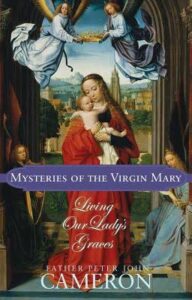 Mysteries of the Virgin Mary approaches the task of increasing understanding of the theology behind Marian doctrine by looking at reasons behind Marian
Mysteries of the Virgin Mary approaches the task of increasing understanding of the theology behind Marian doctrine by looking at reasons behind Marian  feasts throughout the liturgical year. Chapters cover the Birth of Mary, her Presentation, her Immaculate Heart, her Holy Name, and her role as Queen of Heaven, as well as her titles as Our Lady of Sorrows, Our Lady of Guadalupe, and, of course, Our Lady of the Rosary. Read excerpts and learn more about Mysteries of the Virgin Mary and other works related to Bible study at ex libris—main bookshelf.
feasts throughout the liturgical year. Chapters cover the Birth of Mary, her Presentation, her Immaculate Heart, her Holy Name, and her role as Queen of Heaven, as well as her titles as Our Lady of Sorrows, Our Lady of Guadalupe, and, of course, Our Lady of the Rosary. Read excerpts and learn more about Mysteries of the Virgin Mary and other works related to Bible study at ex libris—main bookshelf.
do you know the spiritual fruit associated with the First Glorious Mystery?
Hint: It’s usually listed as the first theological virtue. You can find out what it is in the “Fruits of Prayer” box on page 65 in Scripture & the Rosary: New Testament Mysteries, Old Testament Parallels. In what ways might this fruit benefit you in your everyday life?
visual meditation is a form of prayer
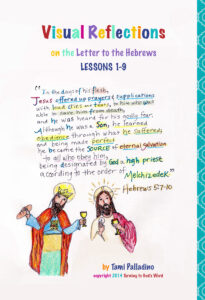 If you like to draw, consider illustrating your prayers for Scripture & the Rosary: New Testament Mysteries, Old Testament Parallels. Check out the visual-meditation journal
If you like to draw, consider illustrating your prayers for Scripture & the Rosary: New Testament Mysteries, Old Testament Parallels. Check out the visual-meditation journal  that Turning to God’s Word co-founder Tami Palladino created for The Letter to the Hebrews: An Explanation of the Mechanism of Our Salvation. Tami also illustrated Sing a New Psalm: Communicating with God Through the Prayers of the Church—Volume I: Lauds & Vespers and The Revelation of Jesus Christ: The Faithful Witness, and some lessons in You Shall Have No Other Gods: The Book of Exodus and In the Beginning: The Book of Genesis.
that Turning to God’s Word co-founder Tami Palladino created for The Letter to the Hebrews: An Explanation of the Mechanism of Our Salvation. Tami also illustrated Sing a New Psalm: Communicating with God Through the Prayers of the Church—Volume I: Lauds & Vespers and The Revelation of Jesus Christ: The Faithful Witness, and some lessons in You Shall Have No Other Gods: The Book of Exodus and In the Beginning: The Book of Genesis.
 the best Catholic commentary about Scripture
the best Catholic commentary about Scripture
To find out more about how Church teaching is supported by passages in Scripture & the Rosary: New Testament Mysteries, Old Testament Parallels, check out the Index of Citations in the Catechism of the Catholic Church. Links (Revised Standard Version Catholic Edition [RSVCE*]) to the primary Scripture passages in the lesson and relevant paragraphs in the Catechism are provided here. Not every passage in the biblical text for this study is referenced in a Catechism paragraph, however, including the passages in this lesson from the Book of Daniel 3:16–20 and the Book of Daniel 3:24–25.
the Gospel According to Mark 16:1—paragraphs 641, 2174
the Gospel According to Mark 16:2—paragraph 2174
the Gospel According to Mark 16:5–7—paragraph 333
the Gospel According to Mark 16:7—paragraph 652
the Gospel According to Mark 16:11—paragraph 643
to learn more, read more Scripture
When you’re having difficulty understanding a passage of Scripture, it can help to read the  cross references—but looking these up takes time. We’ve compiled the cross references from the Revised Standard Version Second Catholic Edition (RSV2CE)—the same translation that we reprint in our study books. The list can be found at the top of every online study page, and it includes links to cross references in the primary biblical texts for all of the lessons in Scripture and the Rosary; New Testament Mysteries, Old Testament Parallels.
cross references—but looking these up takes time. We’ve compiled the cross references from the Revised Standard Version Second Catholic Edition (RSV2CE)—the same translation that we reprint in our study books. The list can be found at the top of every online study page, and it includes links to cross references in the primary biblical texts for all of the lessons in Scripture and the Rosary; New Testament Mysteries, Old Testament Parallels.
don’t forget about our indexes & extra online material

 If you’re trying to locate information about a Scripture passage, you can look it up in the index at the back of the online version of this study. If you want to revisit a commentary, you can look it up by title in the topics index. If you want to learn more about another book of the Bible for which there’s a Turning to God’s Word study, you can read online commentaries and watch any accompanying videos by choosing a lesson from one of the study directories. (There are no lesson videos with Scripture & the Rosary: New Testament Mysteries, Old Testament Parallels.) Finally, if you have a question or would like to make a comment about any of our studies, you can use the “ask us your question” or “what do you think” button to email our authors.
If you’re trying to locate information about a Scripture passage, you can look it up in the index at the back of the online version of this study. If you want to revisit a commentary, you can look it up by title in the topics index. If you want to learn more about another book of the Bible for which there’s a Turning to God’s Word study, you can read online commentaries and watch any accompanying videos by choosing a lesson from one of the study directories. (There are no lesson videos with Scripture & the Rosary: New Testament Mysteries, Old Testament Parallels.) Finally, if you have a question or would like to make a comment about any of our studies, you can use the “ask us your question” or “what do you think” button to email our authors.
ex libris—Church documents & books about religious topics
Link to magisterial documents referred to in our Bible studies at ex libris—magisterial documents.  This listing includes significant recent encyclicals as well as a number of historical Church documents. Recommended books related to Scripture study can be found at ex libris—main bookshelf.
This listing includes significant recent encyclicals as well as a number of historical Church documents. Recommended books related to Scripture study can be found at ex libris—main bookshelf.
memorize a favorite Bible verse (4:48)
Turning to God’s Word co-founder Tami Palladino has created a short video about the benefits of memorizing Bible verses. Choosing a passage that you find particularly meaningful will make the task easier. There are inspiring verses in every book of the Bible, but some people in our Turning to God’s Word Catholic Bible studies like to memorize a verse from their lesson every week. For more ideas and helpful tips, check out Tami’s video, Why Memorize Scripture? It’s less than five minutes long.
wondering how to pronounce some of these words?
The following links are to readings from the New International Version (NIV) Bible. To listen, click on the audio icon above the printed text. Although not taken from the translations used in our study materials, the NIV readings provide an audio guide to pronunciation of words in this lesson’s primary biblical texts. A close online version of the translation of the Bible used in Catholic liturgy in the United States as well as an audio guide for daily Mass readings for the current month can be found on the website of the United States Conference of Catholic Bishops (USCCB).
the Gospel According to Mark 16:1–11 (NIV)
the Book of Daniel 3:16–20 (NIV)
the Book of Daniel 3:24–25 (NIV)
close by praying the First Glorious Mystery
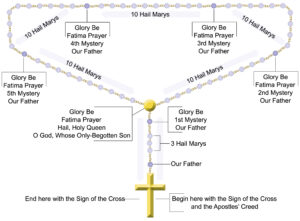 Many of our study groups like to conclude discussions of Scripture & the Rosary: New Testament Mysteries, Old Testament Parallels by praying a decade of the Rosary devoted to the Mystery that’s the focus of their lesson. A number of Catholics include a request for an increase in the spiritual fruit associated with the mystery. You can find out what’s associated with the First Glorious Mystery in the “Fruits of Prayer” box on page 65 in Scripture & the Rosary: New Testament Mysteries, Old Testament Parallels.
Many of our study groups like to conclude discussions of Scripture & the Rosary: New Testament Mysteries, Old Testament Parallels by praying a decade of the Rosary devoted to the Mystery that’s the focus of their lesson. A number of Catholics include a request for an increase in the spiritual fruit associated with the mystery. You can find out what’s associated with the First Glorious Mystery in the “Fruits of Prayer” box on page 65 in Scripture & the Rosary: New Testament Mysteries, Old Testament Parallels.
 We invite you to pray along with Turning to God’s Word co-founder Tami Palladino and her daughter Anne Marie on their prayer video featuring the First Glorious Mystery of the Rosary. The prayers and videos for all 20 mysteries are accessible year-round at how to pray the Rosary, and you can access a link to Tami and Anne Marie’s how-to video to learn what’s important about praying the Rosary. Clicking on the diagram (above) will take you to the website page with the Rosary prayers.
We invite you to pray along with Turning to God’s Word co-founder Tami Palladino and her daughter Anne Marie on their prayer video featuring the First Glorious Mystery of the Rosary. The prayers and videos for all 20 mysteries are accessible year-round at how to pray the Rosary, and you can access a link to Tami and Anne Marie’s how-to video to learn what’s important about praying the Rosary. Clicking on the diagram (above) will take you to the website page with the Rosary prayers.
Lesson 18 Why Do You Stand Looking into Heaven? (the Second Glorious Mystery, the Ascension)—the Acts of the Apostles 1:6–11 and the Second Book of the Kings 2:6–14
Lesson 16 There They Crucified Him (the Fifth Sorrowful Mystery, Jesus Is Crucified)—the Gospel According to John 19:18–35, Psalm 22:1–8, and Psalm 22:16–18
you also may like our two-part study of the prophets
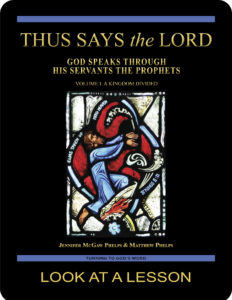
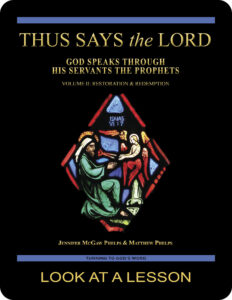 Thus Says the LORD: God Speaks Through His Servants the Prophets—Volume I: A Kingdom Divided examines the prophets in their historical context using the First and Second Books of the Kings and other Old Testament passages written before the Babylonian Exile in 586 B.C. Volume II: Restoration & Redemption looks at the post-exilic prophets. This 51-lesson Catholic Bible study builds on The United Kingdom of Israel: Saul, David & Solomon Foreshadow Christ the King. Click on the books’ covers to view a sample lesson from each volume.
Thus Says the LORD: God Speaks Through His Servants the Prophets—Volume I: A Kingdom Divided examines the prophets in their historical context using the First and Second Books of the Kings and other Old Testament passages written before the Babylonian Exile in 586 B.C. Volume II: Restoration & Redemption looks at the post-exilic prophets. This 51-lesson Catholic Bible study builds on The United Kingdom of Israel: Saul, David & Solomon Foreshadow Christ the King. Click on the books’ covers to view a sample lesson from each volume.
start a Turning to God’s Word Bible study
 Thank you for your interest in Scripture & the Rosary: New Testament Mysteries, Old Testament Parallels.
Thank you for your interest in Scripture & the Rosary: New Testament Mysteries, Old Testament Parallels.  Information about beginning a Turning to God’s Word Bible study can be found at start a Bible study. Tami, Matthew, and I are available to answer your questions and to offer support. You may use this email to contact us directly if you’re interested in starting a Turning to God study or in having your study schedule listed with other TtGW study groups on our website. —Jennifer
Information about beginning a Turning to God’s Word Bible study can be found at start a Bible study. Tami, Matthew, and I are available to answer your questions and to offer support. You may use this email to contact us directly if you’re interested in starting a Turning to God study or in having your study schedule listed with other TtGW study groups on our website. —Jennifer
*There are seven deuterocanonical books in the Old Testament—the Books of Tobit, Judith, Wisdom, Sirach, Baruch, and First and Second Maccabees, as well as some passages in the Books of Esther and Daniel. Protestants usually refer to these works as “apocryphal,” a word that means “outside the (Protestant) canon” because they’re excluded from most Protestant Bibles. The word “deuterocanonical” means “second canon”; Catholics use that word to refer to any section of the Catholic Old Testament for which there are no extant, or existing, Hebrew manuscripts. All of the deuterocanonical books appear in the Septuagint, the earliest remaining versions of which date to the 1st century B.C. This Greek translation of the Old Testament was in common use by Jews at the time of Jesus—but the same books aren’t found in existing Hebrew manuscripts, which aren’t as old as the oldest version of the Septuagint. Learn more by reading How Do Catholic & Protestant Bibles Differ?
Turning to God’s Word printed Bible studies use the 2006 Revised Standard Version Second Catholic Edition (RSV2CE) translation for all Scripture references except those to the Psalms, which are taken from The Abbey Psalms and Canticles, prepared by the Benedictine monks of Conception Abbey and published in 2020 by the United States Conference of Catholic Bishops (USCCB). All Scripture links for the digital version of Scripture & the Rosary: New Testament Mysteries, Old Testament Parallels are to the 1966 Revised Standard Version Catholic Edition (RSVCE) translation. The New International Version (NIV) audio recordings follow the same chapter and verse numbering as the RSV Catholic translations, but the NIV translation doesn’t include the deuterocanonical books and passages.
The 1966 RSVCE uses archaic pronouns and verb forms such as “thee,” “thou,” “didst” in the Psalms and in direct quotations attributed to God. The 2006 RSV2CE replaces those with more accessible English. The few significant translation changes in the RSV2CE include rendering almah as “virgin” in the Book of Isaiah 7:14 and restoring the term “begotten” in the Gospel According to John 3:16.
Numbering varies for some passages in this Bible study. Turning to God’s Word studies follow the numbering in the Revised Standard Version Catholic translations (RSV2CE and RSVCE). Discrepancies in the New American Bible Revised Edition (NABRE) are noted in the Index of Scripture Citations.
 You can learn more about the Psalms by viewing a sample lesson from the Turning to God’s Word Catholic Bible study Sing a New Psalm: Communicating with God Through the Prayers of the Church—Volume I: Lauds & Vespers. The second part of that study, Sing a New Psalm: Communicating with God Through the Prayers of the Church—Volume II: Vigils, Day Prayer & Compline, is scheduled for publication in 2025. Some verse numbers may vary in different translations of the Psalms.
You can learn more about the Psalms by viewing a sample lesson from the Turning to God’s Word Catholic Bible study Sing a New Psalm: Communicating with God Through the Prayers of the Church—Volume I: Lauds & Vespers. The second part of that study, Sing a New Psalm: Communicating with God Through the Prayers of the Church—Volume II: Vigils, Day Prayer & Compline, is scheduled for publication in 2025. Some verse numbers may vary in different translations of the Psalms.
